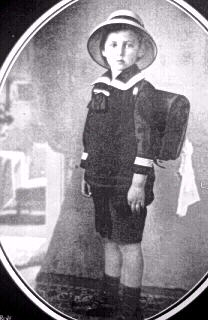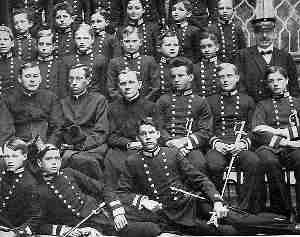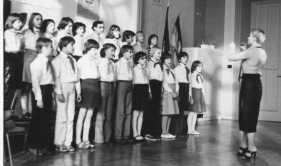
Figure 1.--A young German boy in the early 1920s prepared for school. The sailor suit was his mother's choice, not required by the school.
German schools have never required school uniforms as in Britain and other
European countries. A specific school uniform seems to be more an
Anglo-Saxon/Brtitish Empire institution. As a result, there is no traditional school boy
dress associated with Britain as is the case of British school boy caps
and blazers or Italian and French schoolboy smocks.
School uniforms were not common in Germany which is interesting as turn of the century Germans appear to have had a penchant for uniforms. This included dress

Figure 1.--A young German boy in the early 1920s prepared for school. The sailor suit was his mother's choice, not required by the school. |
There were military-style uniforms at German and Austrian
cadet schools. Several books and films have been set at these schools. One of the most
famous books is Young Torless. Films have included
Colonel Redl and the book and BBC TV serial A
Legacy.
The lack of school uniforms continued after the First World War
and were not worn during the Weimar and NAZI period. In the Nazi period there were
uniforms for almost everybody and anyone without some
kind of be-swastika-ed uniform must have felt left out. So it is
curious that uniforms were not instituted for school children. Of course all the Aryan
children had their Hitler Youth uniforms.
After the war there was such a general revulsion against the Nazi obsession with uniforms.
The disaster
of the Second World War had a profound impact on the German people and
any consideration of school uniform in post-war Germany would have been
impossible because of the perceived military-like enforcement of uniformity.
After the War neither the Communist East (DDR) or the
democratic
West (BRD) introduced school uniforms. After the war the idea of putting
another generation in any kind of uniform was certainly a deterrent in the DFR. But on the
other handside: the model for the DDR was the USSR, and the
children there had to wear school uniforms. The absence of required school
uniforms continues in today's unified Germany.
One observer from former East Germany reports: I don’t know much
about this kind of schools in Western Germany, but I
am sure schools there do not have uniforms, otherwise I would have heard a little more
about them. Here in Germany there is a strict separation between church and
state/government. In Bavaria, a very religous part of
Germany, there were recently lawsuits about crucifixes in classrooms.
Some parents said that religious symbols like crucifixes violate the
the right of their children for freedom of religion. They won the lawsuits, and
the schools have had to remove the crucifixes, if only one student in
the class demanded it.
German and Austrian choirs had uniforms. Even some schools which were related with the church, like the Thomas-School in Leipzig, home of the world-famous »Thomanerchor« (St.Thomas boys choir), were

Figure 2.--Some of the few German and Austrian schools that required uniforms were the military preparation cadet schools. The Vienna Choir Boys in the Austro-Hungarian Empire wore military uniforms. |
Modern Germany is confronting many of the same problems faced by schools in the United States and other western countries. There is now a movement in the United States to introduce school uniforms, at least in elementary and junior high schools. Some German legislators are now suggesting that German schools introduce school uniforms. A member of the German Parliament's children commission during April 1998 suggested that the country should consider pilot projects to assess school uniforms in Germany. The idea is to avoid the increasing problems based on the differences between kids from poor and rich families. In recent times clothing of popular brands (like Reebok, Adidas and so on) have become increasingly important, but poor families can’t provide their children with it. So an increasing number of robberies and blackmailing are being reported as young

Figure 3.--Children in the old DDR, as children in BRD, did not wear school uniforms, although on special occasions they would wear their Young Pioneer uniforms. |
I have to say that I don’t
like the idea of a uniform, but I also can understand the arguments of
the pro-fraction. My little brother had last year some unpleasant
experiences with two older guys who thought it would be a nice idea to
let him pay for the right to pass their street on his way to school.
Luckily I was able to end this quite fast, but I know that other kids
weren’t so successful. So the question about school-uniforms is a tough
decision. I would hate to have to wear the same clothing as anyone else,
but to stay objective I have to say that school-uniforms have their
advantages. And neither my brother or me had and have to worry about
having the money to buy the new Levi’s or not. I think most parents
would like the idea, but most kids would hate it. Especially in a
country where quite a lot of generations were raised without
school-uniforms and a cool »image« has become more and more important
especially for the teens.
Peter Conrad, April 11, 1998
Last updated: April 11, 1998